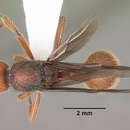en
names in breadcrumbs


Diagnosis of queen
Ants belonging to the subfamily Myrmicinae.
1. Mandibles triangular, with a series of 9 teeth on the masticatory margin, the apical tooth being the largest.
2. Palp formula 3,2 (in situ count).
3. Anterior clypeal border convex, medially produced into a blunt point and covering basal mandibular margins.
4. Clypeus posteriorly narrowly inserted between the widely separated frontal lobes.
5. Clypeus with longitudinal rugae, not distinctly bicarinate but with a prominent anteromedian carina.
6. Lateral portions of clypeus not posteriorly raised into a shield-wall in front of the antennal fossae.
7. Anterior margin of clypeus with hairs but without a single prominent median seta.
8. Frontal carinae extend posteriorly to slightly behind the eyes; almost as long as the scapes and posteriorly diverging one from another.
9. No evident antennal scrobe present.
10. Antennae with 12 segments, funiculus clavate with a vague 3-merous club; each funicular segment sharply constricted one from another.
11. Frontal triangle well defined, smooth and shining.
12. Propodeal spiracle situated slightly above mid-height of sclerite, close to junction of metapleuron and anterad of teeth, well back from the edge of the declivitous face.
13. Declivitous propodeal face with a pair of sharply pointed triangular lateral teeth joined by carinae to the well developed, bluntly pointed inferior propodeal plates.
14. Posteroventral alitrunk with a median convex emargination, not open and extending anterad of hind coxae.
15. Metasternal process absent.
16. Strongly pedunculate petiole, node conical with a bluntly pointed apex, petiolar ventrum with a low longitudinal carina, no prominent process.
17. Petiolar spiracle is at mid-peduncular length.
18. Postpetiolar node dome-shaped as seen laterally, and campaniform dorsally; prominent transverse subpostpetiolar process.
19. Sting weakly sclerotized and ending in a prominent lobular flange.
20. Apex of meso- and metatibiae each with a single simple spur.
21. Strongly sculptured cuticle except for gaster.
Features of the anterior wing venation include Mfl branching out quite distad of cu-a, the absence of 1r and r-m, the continuity of 2r and Rsf2-3. One cubital cell is present and the radial cell is closed. The posterior wing has only one cell, neither Rs, M, nor CuA extends after r-m, and M-Cu does not reach the wing base. A thickened cu-a reaches toward but does not touch the brief and thick anal vein. Wings with abundant decumbent pilosity, borders of posterior wings with a fringe of short hairs, but such a fringe lacking about the anterior wings.
Bariamyrma (from "Baria", name of a river; Latin hispidula, diminutive for "hairy, bristly") is a genus of ants in the subfamily Myrmicinae containing the single species Bariamyrma hispidula.[1] The genus is known only from queens from Venezuela.[2]
Bariamyrma (from "Baria", name of a river; Latin hispidula, diminutive for "hairy, bristly") is a genus of ants in the subfamily Myrmicinae containing the single species Bariamyrma hispidula. The genus is known only from queens from Venezuela.